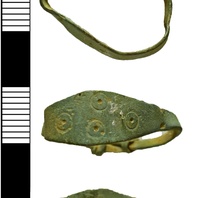
Viking Objects
Stamped Finger-Ring (NARC-031C88)
A stamped copper-alloy finger ring decorated with four double ring-and-dots in a lozengiform arrangement. Ring-and-dot was a decorative technique used at various periods from the later Iron Age onwards, but which enjoyed a Viking Age revival. Rings like this with knotted ends are typically Scandinavian.
Read More

Item
Haverholme
Haverholme, in Kesteven, Lincolnshire, comes from Old Norse hafri ‘oats’ and Old Norse holmr ‘an island, an inland promontory, raised ground in marsh, a river-meadow’. In 1137 the site was given by Alexander, Bishop of Lincoln, to the Cistercians of Fountains Abbey who later left Haverholme for Louth Park and the manor was passed to the Gilbertines in 1139.
Read More
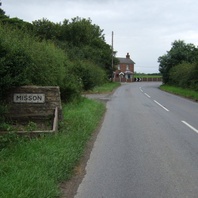
Viking Names
Misson
Misson, in the Bassetlaw Wapentake of Nottinghamshire, is a difficult name. It may be a river name, of which the first element has affinities with Danish mysse, Swedish myssene, or Old Norse mysni ‘a water-plant (?water-arum)’ either as a simplex name or combined with Old Norse á ‘a river’. Alternatively, the name might derive from Old English mos ‘a bog, a swamp; presumably also moss’.
Read More
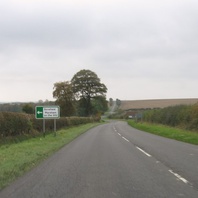
Viking Names
Scrafield
Scrafield, in the Hill Wapentake of Lincolnshire, is probably an Anglo-Scandinavian hybrid from Old Norse skreið ‘a land-slide’ and Old English feld. The latter element has a wide range of meanings in place-names, including ‘open country, unencumbered ground (eg. land without trees as opposed to forest, level ground as opposed to hills, land without buildings)’ and from the late tenth century it also refers to arable land.
Read More
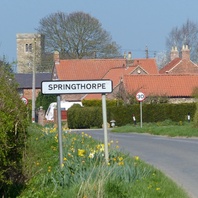
Viking Names
Springthorpe
Springthorpe, in the Corringham Wapentake of Lincolnshire, is an Anglo-Scandinavian compound from Old English spring ‘a spring, a well, the source of a stream’ and Old Norse þorp ‘a secondary settlement, a dependent outlying farmstead or hamlet’.
Read More
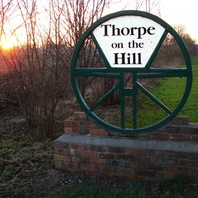
Viking Names
Thorpe on the Hill
Thorpe on the Hill, in the Graffoe Wapentake of Lincolnshire, is a simplex place-name coming from Old Norse þorp ‘a secondary settlement, a dependent outlying farmstead or hamlet’. The affix is self-explanatory.
Read More
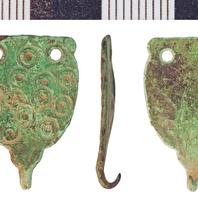
Viking Objects
Hooked Tag (NLM-8E96D5)
This example of an Anglo-Scandinavian copper-alloy hooked tag is classed as a Read Class A Type 1 or Class B Type 1. The tag is decorated with a stamped ring-and-dot motif which was a popular style among Scandinavians.
Read More
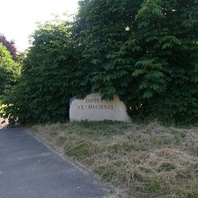
Viking Names
Driby
Driby, in the East Lindsey district of Lincolnshire, is an Anglo-Scandinavian hybrid name from Old English dryge ‘dry, dried up’ and Old Norse bý ‘a farmstead, village’.
Read More
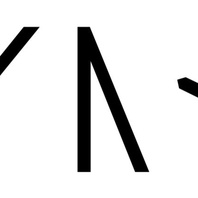
Viking Names
Asmund
Ásmundr is a very common name in Scandinavia throughout the Viking Age and later. It is recorded in medieval documents from both Lincolnshire and Yorkshire, in field-names in Lincolnshire, and in major names in North and West Yorkshire such as Osmotherley and Osmondthorpe. It is an Old Norse compound name. Its first element Ás- ‘a god’, frequent in Viking Age names, presumably refers to Old Norse deities such as Odin and Thor, though the latter name appears in its own right in many names, both male and female, while Odin is a very rare element in personal names. The second element-mundr is either Old West Norse ‘protector’ or Old Norse-Icelandic ‘gift’.
Read More
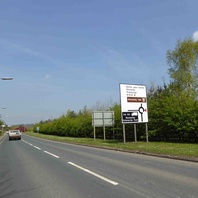
Viking Names
Flixborough
Flixborough, in the West Riding of Lindsey in Lincolnshire, is a hybrid name from the Old Norse male name Flík and Old English burh ‘a fortified place’. It is highly likely, in a place-name with Old English burh as the second element, that the Old Norse Flík has replaced an earlier Old English name or element. An important Anglo-Saxon settlement site has been excavated here.
Read More
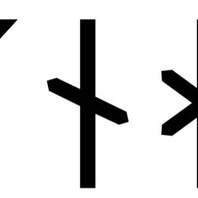
Viking Names
Hrafnhild
Hrafnhildr is recorded in a few instances in West Scandinavia (Norway and Iceland) and in the quasi-historical Icelandic text, Landnámabók ‘The Book of Settlements’ which recounts the settlement of Iceland. It is also attested in two field names in West Yorkshire. The personal name is an Old Norse compound, formed from Hrafn- , ‘raven’, combined with -hildr, ‘battle’.
